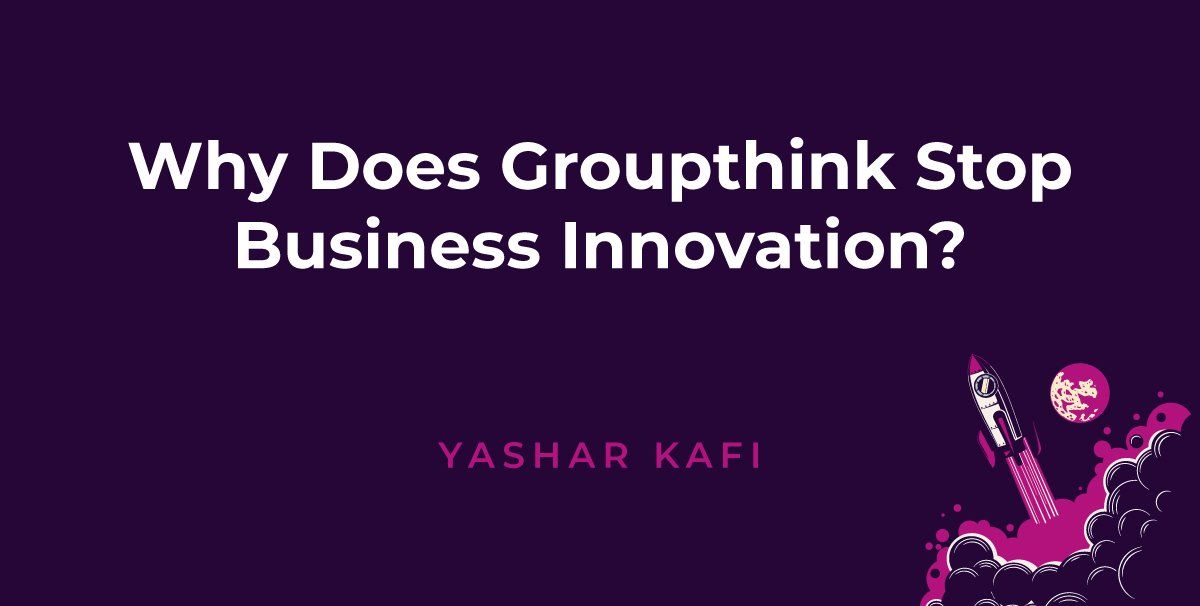Why Does Groupthink Stop Business Innovation?
Business innovation is what all companies are after. But it isn’t always as easy as it sounds to keep that creative spark and idea machine humming. If you are a leader who feels like your efforts in innovation have been uninspired, and you are looking for new and inventive ways to lead your teams, you are not alone.
We know how many roadblocks can arise to bar your progress, a common one being groupthink. This article explains how groupthink sometimes kills innovation. We explore why that is and what we can do to stop it.
What Is Groupthink?
Groups and naysayers stop innovation. And groupthink is a massive culprit.
Often, groupthink is the place where innovative ideas go to die. Simply defined, groupthink is a phenomenon that occurs when everyone in the group discussing a matter comes to the same conclusion or decision since that’s what the common consensus is. As a result, people make decisions as one collective group rather than a collective of individual voices with differing opinions and thoughts.
At its most benign, groupthink discourages out-of-the-box thinking, creativity, and individual contribution. A downside to this is that it leaves no room for differing opinions, which then leaves room for huge blind spots resulting from a lack of close evaluation or alternative options.
While this may seem harmless—or even a positive since everyone is in perfect agreement—the fallout results from groupthink’s homogenous nature. In other words, innovation has no room for birth because many individual ideas never see the light of day. You’ve likely heard the analogy of iron sharpening iron, or even think of sandpaper—the concept that some friction (in this case, differing opinions) is needed for producing the ideal result.
So, how do we come up with new and unique ideas? Some companies try brainstorming.
Brainstorming and Business Innovation – Is Brainstorming Best?
Teams everywhere rely on brainstorming, but is it the best method? Brainstorming is a technique first introduced by Alex Osborn in the 1950s. The concept caught on like wildfire and is still used today in corporate offices worldwide. But if you ask Harvard Business Review expert and Chief Innovation Officer at ManpowerGroup, Tomas Chamorro-Premuzic, brainstorming is a waste of time.
According to Chamorro-Premuzic, even though Osborn claimed brainstorming increased innovative ideas by 50% compared to individuals finding solutions on their own, more than six decades of independent scientific research shows little to no evidence of this. Instead, more evidence supports the idea that brainstorming hinders creativity, thus hindering collective performance—none of which is a resounding recommendation for leaders to jump onboard with brainstorming as a catalyst for innovation.
Results from a meta-analytic review of over 800 teams revealed that individuals tend to produce more original ideas when not interacting with others. But do you have to brainstorm in a group? Of course not. You can brainstorm solo or as part of a team, and there are loads of techniques.
How To Push Through Negativity
When bouncing ideas around, there is always the inevitable negativity that enters the chat. Assigning one person to be a devil’s advocate is often helpful. Having one designated person question the ideas provided may foster critical thinking within the group.
However, if there is more harmful negativity threatening to stifle innovative ideas, it will need to be reined in. An article from MIT has some excellent tips about how criticism can boost creativity.
The main thing is that your team gets the opportunity, freedom, support, and proper tools to voice their opinions—ideas that will be your best hope for true innovation to thrive. The last thing that fosters innovation is a toxic workplace culture filled with negativity or suppression of individuality.
Want to learn more about increasing innovation in your organization and more? Connect with us to get started today.




